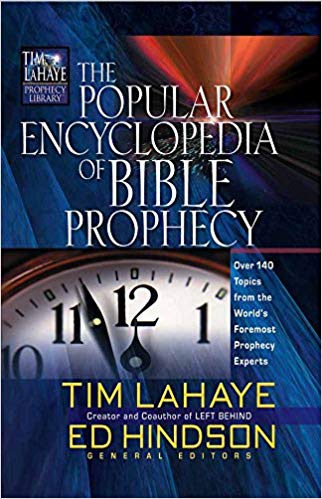ABOMINATION OF DESOLATION PART 3

THE POPULAR ENCYCLOPEDIA OF BIBLE PROPHECY
ABOMINATION OF THE ANTICHRIST
Paul introduces the desecration of the Temple in 2 Thessalonians 2:4 by saying that the man of lawlessness “exalts himself.” He elevates
himself “over every so-called god or object of worship.” While this might indicate a superlative blasphemy of God such as in Revelation 13:6, the immediate setting is the future (rebuilt) Jerusalem Temple, and so the
“objects of worship” are sacred vessels (see 2 Chronicles 5:5-7; Hebrews 9:2-5) and the “desolation” occurs within the innermost sacred part of the Temple (the Holy of Holies),where God’s presence was previously manifested (Exodus 25:22; 30:6; see also Ezekiel
43:1-7). The abomination, however, is the Antichrist’s act of enthroning himself in the place of deity to “display himself ” (Greek, apodeiknunta)
as God (literally, “that he is God”). This blasphemous act fulfills Daniel’s prediction that the Antichrist “will exalt and magnify himself above every god and will speak monstrous things against the God of gods” (Daniel
11:36). With the satanic background of Revelation 12:9,12-17; 13:4-10, the abomination has allusions to Isaiah 14:13-14 and Ezekiel 28:2-9, where the usurping figures “raise [their] throne above the stars of God,” “make [themselves] like the Most High,” and declare, “I am god; I sit in the seat of the gods.”Despite the precedent of the literal interpretation
of the Olivet Discourse, which clearly refers to the desecration of the historic Jewish Temple in Jerusalem, some interpret 2 Thessalonians 2:4 in a nonliteral manner, taking “the temple of God” metaphorically as a reference to the church. They view the act of desecration by the “man of lawlessness” as apostasy in the church. However, writing to
a first-century audience at a time when the Second Temple was still standing, Paul’s reference to “the temple of God” could only mean one place—the Jewish Temple in Jerusalem. We also have other reasons for rejecting the symbolic interpretation and applying the prophecy to a literal Temple (and therefore a literal abomination of desolation): (1) In the few places where Paul used the Greek word naos (“temple”) to mean something other than the actual Holy Place at Jerusalem (1 Corinthians 3:16; 6:19; 2 Corinthians 6:16; Ephesians 2:21), he always explained his special meaning so that his readers would understand his metaphorical usage. (2) The word “temple” in 2 Thessalonians 2:4 has the definite article (“the temple”) in contrast to Paul’s metaphorical usage, where “temple” is usually anarthrous (“a temple).” (3) “In the temple of God” modifies the verb “takes his seat” (Greek, kathisai), a verb suggesting a definite locality,not an institution (such as the church). If Paul were referring to apostasy in the church,
he would better have expressed this with a verb for “enthronement” or “usurpation” rather than a verb that referred to the literal act of
“taking a seat.” The ante-Nicene church fathers affirmed the literal understanding of this passage. For example, Irenaeus (a.d. 185) wrote: “But when this Antichrist shall have devastated all things in this world, he will reign for three years and six months, and sit in the Temple at Jerusalem;
and then the Lord will come from heaven in the clouds, in the glory of the Father, sending this man and those who follow him into the lake of fire; but bringing in for the righteous the times of the kingdom.” Irenaeus’
literal interpretation of the Temple’s desecration is both eschatological and premillennial. By contrast, the symbolic or “spiritual”
use of “temple” for the church does not appear in developed form until the third century a.d. with Origen, who was influenced by the allegorical interpretations of the Hellenistic idealist school of Philo. Consequently, the eschatological interpretation of the abomination of desolation has both textual support and the witness of early church apologists. It warns us of the future day of deception and desolation at the midpoint of the Tribulation, which will call for divine judgment climaxing in the return of the Lord.
—Randall Price
BIBLIOGRAPHY
Dodd, C.H. “The Fall of Jerusalem and the Abomination
of Desolation.” Journal of Roman Studies 37 (1947),
pp. 51-63.
Ford, Desmond. The Abomination of Desolation in Biblical
Eschatology.Washington, DC: University Press of
America, 1979.
Price, Randall. The Desecration and Restoration of the
Temple in the Old Testament, Jewish Apocalyptic Literature,
and the New Testament. Ann Arbor, MI: UMI,
1993.
Wenham, David. “Abomination of Desolation.” In Anchor
Bible Dictionary. New York: Doubleday, 1992.
Zmijewski, J. “Bdelugma.” In Exegetical Dictionary of the
New Testament. Edited by Horst Balz and Gerhard
Schneider. Grand Rapids: Eerdmans Publishing Company,
1978.

